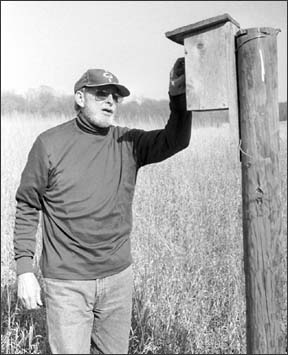 His love for nature started as a small boy growing up in Paynesville. Tom Burr said he saw his first wood duck when he was probably 10 years old.
His love for nature started as a small boy growing up in Paynesville. Tom Burr said he saw his first wood duck when he was probably 10 years old."I lived on the west end of Paynesville by the river," Burr said. "I would feed pheasants as a kid and enjoyed watching the river. I have been concerned about conservation since I was a kid."
Curious about what kind of duck climbs trees, Burr described it to a conservation officer and was told it was a wood duck. The officer also told him there were not enough wood duck homes and told him how to make them.
"As a youth, I made two wood duck homes a year. I would go and get scrap lumber from building projects," Burr said. He found cedar works the best as the wood doesn't rot as fast as others.
Over the years, Burr has altered his design a little, adding an extra block of wood at the entrance. "The extra thickness makes it harder for squirrels and cats to reach into the home and get to the eggs," he said.
Burr said he likes to position the houses in the trees so they face the northwest. "This keeps the hot sun from beating into the hole, keeping the house cooler," he added.
In all, Burr thinks he has more than 40 wood duck houses constructed and positioned high in trees. "I probably have that many bluebird homes scattered throughout the area as well," he said.
Burr places cedar chips in the bottom of all his wood duck houses. He also tacks a strip of fine screening inside the house. Burr said the screen helps the chicks climb out of the house. "They have little hooks on their toes which enable them to climb," he added.
Each spring, Burr makes the rounds and checks his houses, cleaning out last year's nests and getting the houses ready for the wood ducks return.
He places his bluebird houses 10 to 20 feet apart. The tree swallows and bluebirds work together each spring, being neighborly, according to Burr. Once they are gone, he cleans out their homes and when they return, they swap homes. "They never come back to the same home," he explained.
The wood duck houses are positioned about a 100 yards apart high up in trees, making it harder for predators to reach the nests.
"The wood duck young will climb out of the houses and fall to the ground, then walk to water," he explained. "Thus, the need to have the houses located near ponds."
In an attempt to provide his ducks and birds with an adequate amount of food, Burr has planted more than 40,000 trees and shrubs over the years. Food for wildlife, he calls them. Among the items planted have been blue and black spruce trees, high bush cranberries, birch trees, soft maple, red oak, raspberry bushes, and grape vines.
In driving through a wildlife area, he points out that someday this will be covered with trees and shrubs which will provide food for wildlife. Every so often a person sees a bright pink ribbon flying on a twig or whip (tree seedling). The ribbon helps remind Burr where things are planted so he doesn't drive over them when he heads out to check his wood duck or bluebird houses.
In his shop, he has four more wood duck houses ready for a new family. The bluebirds and wood ducks are starting to return and Burr is anxious to get the homes positioned in the woods and on the edges of open fields.